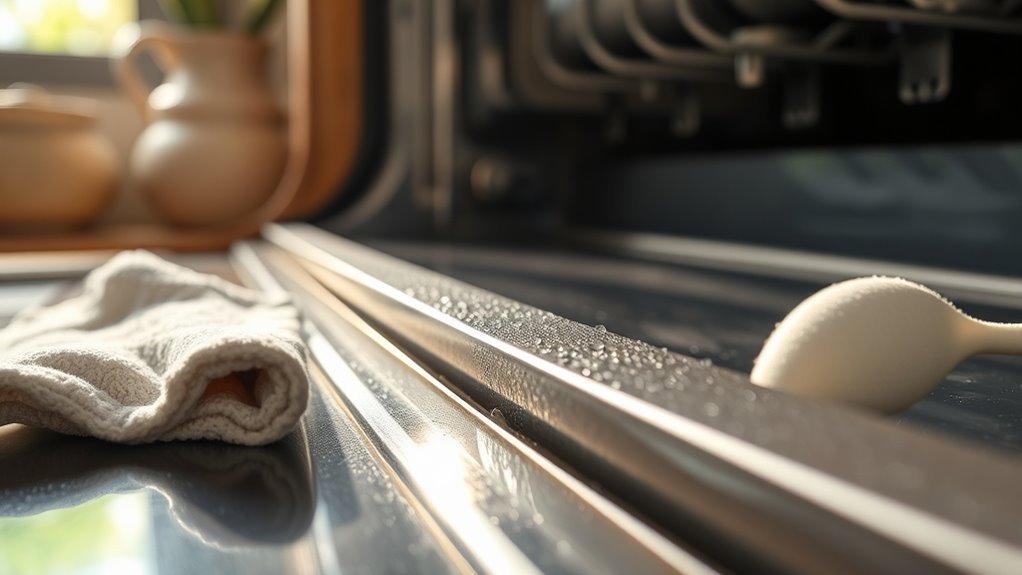Seasonal Maintenance Tips for Dishwasher
To keep your dishwasher running efficiently, inspect and clean the filter and spray arms regularly to prevent clogs. Remove and clean door seals to avoid mold buildup. Run a vinegar cycle and use a dishwasher cleaner monthly to eliminate deposits and odors. Check the water inlet valve and monitor water temperature for ideal cleaning. Choose the right detergent for the season and clean the exterior and control panel carefully. For detailed maintenance steps, further guidance is available to enhance your appliance’s performance.
Inspect and Clean the Dishwasher Filter

Before you begin any deep cleaning, it’s crucial to inspect and clean the dishwasher filter regularly to maintain peak performance. The filter traps food particles and debris, preventing them from clogging the drainage system. For effective filter maintenance, remove the filter assembly according to your dishwasher’s manual, then rinse it thoroughly under running water. Use a soft brush to dislodge stubborn residues without damaging the mesh. Regular cleaning guarantees water flow remains unrestricted and avoids unpleasant odors. If the filter shows signs of wear, damage, or persistent clogging despite cleaning, consider filter replacement to restore ideal function. By prioritizing this simple task, you preserve your dishwasher’s efficiency and extend its service life, granting you the freedom to enjoy hassle-free cleaning without frequent breakdowns or costly repairs. For best results, perform this maintenance regularly to prevent buildup and maintain optimal performance.
Check and Clean Spray Arms
Although spray arms are designed to distribute water efficiently during a wash cycle, mineral deposits and food particles can obstruct their nozzles over time. To maintain peak performance, regular spray arm maintenance is essential. Start by removing the spray arms carefully according to your dishwasher’s manual. Inspect each nozzle for clogs caused by spray arm blockage. Use a toothpick or small brush to clear debris from the holes. Rinse the arms under warm water to flush out loosened particles. Additionally, soak the spray arms in a vinegar solution for 15-30 minutes to dissolve mineral buildup. Once cleaned, reattach the spray arms securely, ensuring they rotate freely without obstruction. Proper spray arm maintenance guarantees effective water distribution, improving cleaning efficiency and extending your dishwasher’s lifespan.
Remove and Clean Door Seals

You should carefully remove the dishwasher door seals to inspect them for mold buildup. Use mild cleaners to avoid damaging the rubber while thoroughly scrubbing away any debris. After cleaning, make sure to dry the seals completely to prevent moisture retention and mold growth. Regularly wiping down the door seals helps prevent grime buildup and extends the life of your dishwasher.
Inspect for Mold
Since mold thrives in damp, hidden areas, it is essential to regularly inspect and clean the dishwasher door seals. These seals often trap moisture, creating a perfect environment for mold growth. For effective mold prevention, carefully detach the door seals according to your dishwasher’s manual. Examine the seals for visible mold or discoloration. Prompt mold removal not only preserves the appliance but also guarantees a hygienic washing environment. Use a soft brush or cloth to access crevices and remove debris. After cleaning, thoroughly dry the seals before reattaching them to prevent moisture accumulation. Regular inspection and maintenance of door seals reduce mold buildup, extending your dishwasher’s lifespan and maintaining peak performance. By staying proactive, you maintain freedom from costly repairs and health hazards associated with mold.
Use Mild Cleaners
When cleaning your dishwasher’s door seals, opting for mild cleaners is essential to avoid damaging the rubber material. Harsh chemicals can degrade the seals, reducing their lifespan and compromising the dishwasher’s efficiency. Instead, choose eco friendly options that effectively achieve stain removal without harming the rubber.
Here are three key steps to follow:
- Use a soft cloth or sponge with a diluted solution of mild dish soap and warm water to gently wipe the seals.
- For stubborn stains, apply a paste made from baking soda and water, letting it sit briefly before wiping clean.
- Avoid abrasive scrubbers or bleach-based cleaners that can erode the seals and release harmful fumes.
Dry Thoroughly After Cleaning
Although cleaning the door seals is essential, drying them thoroughly afterward is equally important to prevent mold growth and maintain their integrity. After removing the seals, use absorbent drying materials such as microfiber cloths or lint-free towels to eliminate residual moisture. Employ drying techniques like gently pressing the cloth along the seals’ crevices to reach hidden damp spots. Avoid air drying alone, as stagnant moisture can remain trapped, fostering bacterial buildup. For enhanced results, you might use a low-heat hairdryer at a safe distance, ensuring the seals don’t warp. Prioritizing effective drying techniques preserves the elasticity and sealing functions, extending the door seals’ lifespan and ensuring your dishwasher operates efficiently without leaks or odors. Following these steps grants you maintenance freedom and peace of mind.
Run a Vinegar Cleaning Cycle

You’ll want to run a vinegar cleaning cycle to effectively remove mineral deposits and eliminate odors inside your dishwasher. Simply place a cup of white vinegar in a dishwasher-safe container on the top rack and run a hot water cycle without detergent. This process helps maintain peak performance and extends the appliance’s lifespan.
Benefits of Vinegar Cleaning
Because vinegar acts as a natural descaler and disinfectant, running a vinegar cleaning cycle in your dishwasher effectively removes mineral buildup, grease, and odors. Its unique vinegar properties, including acidity and antimicrobial effects, make it a powerful cleaning agent without harsh chemicals. Here are the primary vinegar benefits you gain:
- Enhanced Performance: Vinegar dissolves limescale and prevents clogging, ensuring your dishwasher runs efficiently.
- Improved Hygiene: Its disinfectant nature reduces bacteria and mold, promoting a healthier environment.
- Odor Elimination: Vinegar neutralizes unpleasant smells, leaving your dishwasher fresh.
Using vinegar leverages these benefits while maintaining appliance integrity, granting you freedom from costly repairs and chemical cleaners. This natural method optimizes cleaning cycles, ensuring your dishwasher stays in peak condition.
How to Run Cycle
When running a vinegar cleaning cycle, you’ll want to guarantee the dishwasher is empty and free of any detergent or dishes to maximize effectiveness. First, place a cup of white vinegar in a dishwasher-safe container on the top rack. Then, select the appropriate cycle settings—usually a normal or heavy wash cycle works best. Make sure to run empty, as adding dishes can reduce the vinegar’s cleaning power. This process removes buildup and odors, restoring your dishwasher’s efficiency.
| Step | Action | Notes |
|---|---|---|
| 1 | Empty dishwasher | No detergent or dishes |
| 2 | Add vinegar | Use 1 cup in a dishwasher-safe container |
| 3 | Select cycle settings | Normal or heavy wash |
| 4 | Start cycle | Run empty |
| 5 | Finish & wipe down | Clean seals and filters |
Use a Dishwasher Cleaner Monthly
Although your dishwasher rinses away food particles, mineral deposits and detergent residues can still accumulate over time, reducing its efficiency. To maintain peak dishwasher performance, incorporate a monthly cleaning routine using a specialized dishwasher cleaner. This step is critical for effective dishwasher maintenance and improving cleaner effectiveness.
Regular monthly cleaning with a specialized dishwasher cleaner prevents buildup and maintains optimal performance.
- Select a cleaner designed to dissolve limescale and grease buildup.
- Follow the product instructions precisely, typically running a hot cycle with the cleaner.
- Regular monthly use prevents blockages, odors, and mechanical wear.
Additionally, running an empty cycle with a dishwasher cleaner helps eliminate trapped odors and enhances water flow during wash cycles, promoting efficient dishwasher performance and preventing unpleasant odors.
Check and Clear the Drain Hose
You should regularly inspect the dishwasher’s drain hose for blockages that can cause water to back up or drain slowly. When removing and reinstalling the hose, make certain it is securely connected and positioned to prevent kinks or leaks. Proper maintenance of the drain hose is essential for peak dishwasher performance and preventing water damage.
Inspect Hose for Blockages
One essential step in maintaining your dishwasher is inspecting the drain hose for blockages, which can prevent proper water drainage and cause malfunctions. Regular hose inspection is vital for blockage prevention and guarantees peak dishwasher performance. Here’s how to proceed:
- Disconnect the hose carefully from the dishwasher and the drain connection.
- Visually examine the hose for kinks, debris buildup, or any signs of wear that could lead to blockages.
- Flush the hose with water or use a flexible brush to clear out any obstructions.
Performing these steps during seasonal maintenance frees you from potential clogs, preserving water flow and preventing costly repairs. Effective hose inspection directly supports your dishwasher’s longevity and efficiency.
Proper Hose Reinstallation
After thoroughly checking and clearing the drain hose, it is crucial to guarantee its proper reinstallation to maintain ideal dishwasher function. Begin by ensuring correct hose alignment; the hose must follow the manufacturer’s specified routing to prevent kinks or bends that obstruct water flow. Secure the hose firmly to both the dishwasher outlet and the drain connection using appropriate clamps or fasteners. If you notice any cracks, brittleness, or persistent blockages during inspection, consider hose replacement to avoid leaks or drainage issues. Proper reinstallation not only prevents water backflow but also extends the hose’s lifespan. Remember, meticulous hose alignment and secure fittings are critical for efficient drainage and to maintain your dishwasher’s performance without unnecessary repairs or restrictions on your freedom to enjoy hassle-free cleaning cycles.
Inspect and Maintain the Water Inlet Valve
Although often overlooked, the water inlet valve plays a critical role in regulating the flow of water into your dishwasher. Confirming its proper function is essential for ideal water flow and preventing leaks or malfunctions. To effectively inspect and maintain the valve, follow these steps:
- Visual Inspection: Check for any visible damage, corrosion, or debris around the valve and its connections.
- Test Water Flow: Run a cycle and monitor water intake; irregular flow may indicate a clogged or faulty valve.
- Valve Replacement: If you notice persistent water flow issues or valve damage, replace the valve promptly with a compatible model to restore functionality.
Maintaining the water inlet valve confirms reliable dishwasher performance and extends the appliance’s lifespan without compromising your operational freedom. Additionally, scheduling regular maintenance and inspections can prevent unexpected failures and keep your dishwasher running smoothly, similar to how regular maintenance enhances hygiene and function in other household systems.
Clean the Exterior and Control Panel
When you want to keep your dishwasher looking sharp and functioning smoothly, regularly cleaning the exterior and control panel is crucial. Start by identifying the exterior materials—stainless steel, plastic, or painted surfaces—then select appropriate cleaning agents that won’t cause damage or corrosion. Use a soft cloth dampened with mild detergent to wipe down the exterior, avoiding abrasive pads that can scratch surfaces. For the control panel, confirm it’s powered off before cleaning to maintain control panel functionality. Gently remove dust and grime with a microfiber cloth slightly moistened with water or a specialized electronics cleaner. Avoid excess moisture to prevent electrical issues. Maintaining a clean exterior and responsive control panel not only preserves your dishwasher’s appearance but also guarantees reliable operation and user control freedom. Regular wiping of door edges and gasket daily is recommended to prevent mold and maintain the appliance’s longevity, as noted in maintenance tips.
Monitor and Adjust Water Temperature
Since water temperature directly impacts your dishwasher’s cleaning efficiency and energy consumption, it’s vital to monitor and adjust it accurately. You want to make sure the water temperature stays within the ideal range—typically between 120°F and 150°F—to balance effective cleaning and energy efficiency. Here’s how you can maintain this balance:
- Check your water heater setting: Confirm it’s set to a temperature that supports your dishwasher’s requirements without overheating.
- Use a thermometer: Periodically measure the water temperature entering the dishwasher to verify consistency.
- Adjust dishwasher settings if available: Some models allow you to select temperature levels; choose the one that enhances cleaning while minimizing energy use.
Use the Right Detergent for the Season
Choosing the right detergent for the season can greatly improve your dishwasher’s performance and protect your appliance. Seasonal detergent formulations are designed to enhance detergent effectiveness by addressing temperature and water hardness variations throughout the year. In colder months, enzymes in detergents may act slower, so selecting a detergent with enhanced enzyme activity guarantees thorough cleaning. Conversely, during warmer seasons, detergents with stronger surfactants combat grease effectively. You should also consider water hardness changes that affect detergent solubility and residue buildup. Using a detergent tailored to seasonal conditions prevents inefficient cleaning cycles and extends your dishwasher’s lifespan. By aligning your detergent choice with seasonal factors, you maintain ideal wash quality and safeguard your appliance from mineral deposits and wear, granting you the freedom to rely on consistently clean dishes year-round.
Frequently Asked Questions
Can I Use Bleach to Clean My Dishwasher Safely?
You might worry bleach could damage your dishwasher, but it’s generally not recommended due to corrosion risks. Instead, consider safe cleaning options like vinegar or baking soda, which effectively break down grime without harmful effects. These bleach alternatives maintain your appliance’s integrity while ensuring thorough sanitation. Using these methods gives you freedom from harsh chemicals and keeps your dishwasher running efficiently without compromising its components.
How Often Should I Replace My Dishwasher Racks?
You should consider replacing your dishwasher racks when you notice significant wear, rust, or damage that affects their function. Rack materials, typically vinyl-coated steel, can deteriorate over time due to constant exposure to water and detergents. Since the average dishwasher lifespan is about 9-12 years, racks may need replacement every 5-7 years to guarantee peak performance. Regular inspections help you maintain freedom from unexpected rack failures during cycles.
Is It Necessary to Pre-Rinse Dishes Before Loading?
You don’t necessarily have to pre-rinse dishes before loading, but understanding pre rinse benefits can improve cleaning outcomes. Pre rinsing removes large food particles, preventing clogs and ensuring better water flow. Effective pre rinse techniques include scraping off excess food and briefly rinsing under running water without soaking. This approach saves water and energy, giving you the freedom to maintain dishwasher performance without excessive effort or waste.
Can Running a Dishwasher Empty Damage the Appliance?
They say, “An ounce of prevention is worth a pound of cure.” Running a dishwasher empty isn’t recommended because it can cause dishwasher damage over time. Without water and dishes to absorb heat, the heating element may overheat, leading to premature wear. An empty run wastes energy and may strain components unnecessarily. To protect your appliance and enjoy freedom from costly repairs, avoid running the dishwasher without a full load or water inside.
What Are Common Signs of Dishwasher Motor Failure?
If you notice motor symptoms like unusual noises, failure to start, or a dishwasher that stops mid-cycle, these are common signs of motor failure. You might also experience reduced water pressure or overheating. Addressing these symptoms quickly is essential to avoid further damage. Repair options include motor replacement or professional servicing. You’ll want to weigh cost and convenience to keep your dishwasher running smoothly without limiting your freedom in daily chores.






